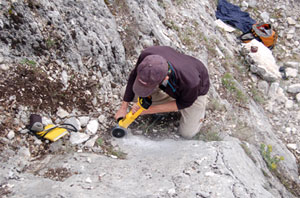 |

|
| Tucker Group Home | People | Research | Publications | Courses | Software | Contact Us |
| RESEARCH GROUPS @ CIRES > |
CU graduate student Scott McCoy collects samples for cosmogenic radionuclide analysis near the scarp of an active fault in the central Apennines. |
Italy normal faulting and erosion projectHow Do Rivers Respond to Growing Mountains?Funding: NSF, UK Natural Environment Research Council Understanding the interaction between earthquakes, geomorphic processes, and mountain landscape evolution is important from a variety of perspectives, including natural hazard management. One way to discover the physics behind mountain landscape evolution is to study natural experiments: case studies in which nature provides enough control that we can use them to test mathematical models. For the past several years, I have collaborated with a team from the U.K. studying a natural experiment in the central Apennines Mountains of Italy. Here, stretching of the earth’s crust has created a network of mountain blocks that are moving relative to one another at rates that have been well documented. One of our main aims has been to examine how rivers in this region have responded to different rates and patterns of rock motion, and use the resulting data to evaluate mathematical models for landscape evolution. Our international research team has compiled a database on rivers and fault blocks in the region. The database includes measurements of channel geometry and hydrology obtained from a combination of field surveys and analysis of digital elevation models, and it includes data three different types of fault block: some have undergone steady vertical motion for two to three million years, while others experienced a three-fold acceleration in rate beginning about 750,000 years ago. Rivers on blocks with steady motion show typical concave-upward profiles with relatively uniform distributions of energy dissipation rate (stream power) and boundary shear stress. By contrast, rivers on accelerated blocks show dramatic steepening in their downstream portions, together with pronounced downstream increases in stream power and shear stress, consistent with a the type of transient response to accelerated fault motion that is predicted by some, but not all, of the current leading models for long-term channel incision. Thus, these findings are helping to elucidate the physics of long-term channel incision into bedrock.
Thick line shows longitudinal profile of a bedrock river channel on an active fault block whose motion accelerated during the Pleistocene period, resulting in steepening of the lower part of the channel; this is compared with computed profiles using both static and dynamic representations of channel width. (Lower left) Time sequence of simulated river profiles; stars indicate back-tilting and deflection of drainage in upper catchment due to fault-block rotation. (Figures from Attal, Tucker, Whittaker, Cowie, and Roberts, 2008 JGR-Earth Surface) References:Attal, M., Tucker, G.E., Whittaker, A.C., Cowie, P.A., and Roberts, G.P. (2008) Modeling fluvial incision and transient landscape evolution: Influence of dynamic channel adjustment: Journal of Geophysical Research, v. 113, doi:10.1029/2007JF000893. Cowie, P.A., Whittaker, A.C., Attal, M., Roberts, G., Tucker, G.E., and Ganas, A. (2008) New constraints on sediment-flux-dependent river incision: implications for extracting tectonic signals from river profiles. Geology, v. 36, no. 7, p. 535-538. Whittaker, A.C., Attal, M., Cowie, P.A., Tucker, G.E., and Roberts, G.P. (2008) Decoding temporal and spatial patterns of fault uplift using transient river long profiles: Geomorphology, v. 100, no. 3-4, p. 506-526, doi:10.1016/j.geomorph.2008.01.018. Whittaker, A.C., Cowie, P.A., Attal, M., Tucker, G.E., and Roberts, G.P. (2007) Bedrock channel adjustment to tectonic forcing: implications for predicting river incision rates: Geology, v. 35, no. 2, p. 103-106 (doi:10.1130/G23106A.1). Whittaker, A.C., Cowie, P.A., Attal, M., Tucker, G.E., and Roberts, G.P. (2007) Contrasting transient and steady-state rivers crossing active normal faults: new field observations from the Central Apennines, Italy: Basin Research (doi:10.1111/j.1365-2117.2007.00337.x). Cowie, P.A., Attal, M., Tucker, G.E., Whittaker, A.C., Naylor, M., Ganas, A., and Roberts, G.P. (2006) Investigating the surface process response of fault interaction and linkage using a numerical modeling approach: Basin Research, v. 18, p. 231-266.
|

